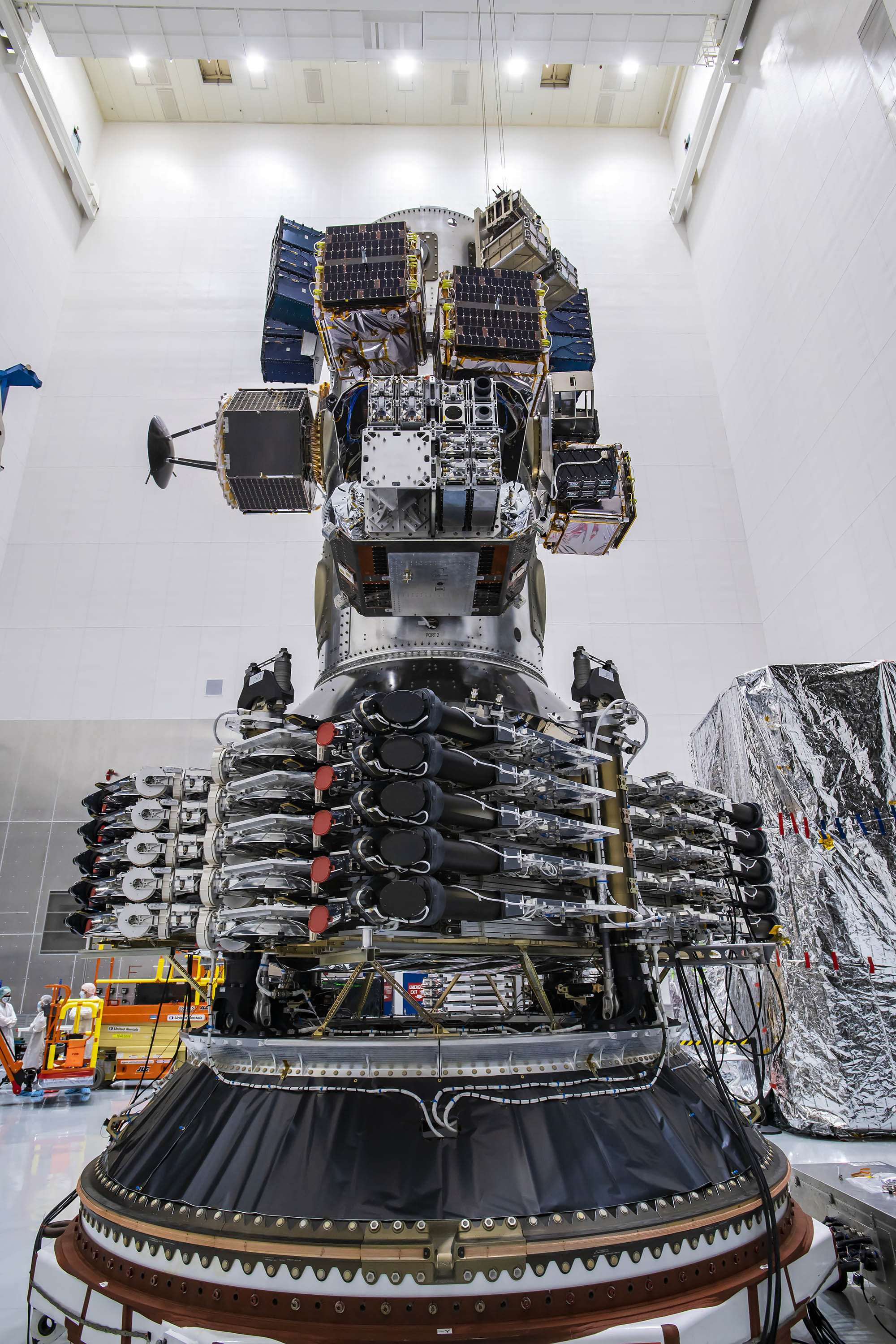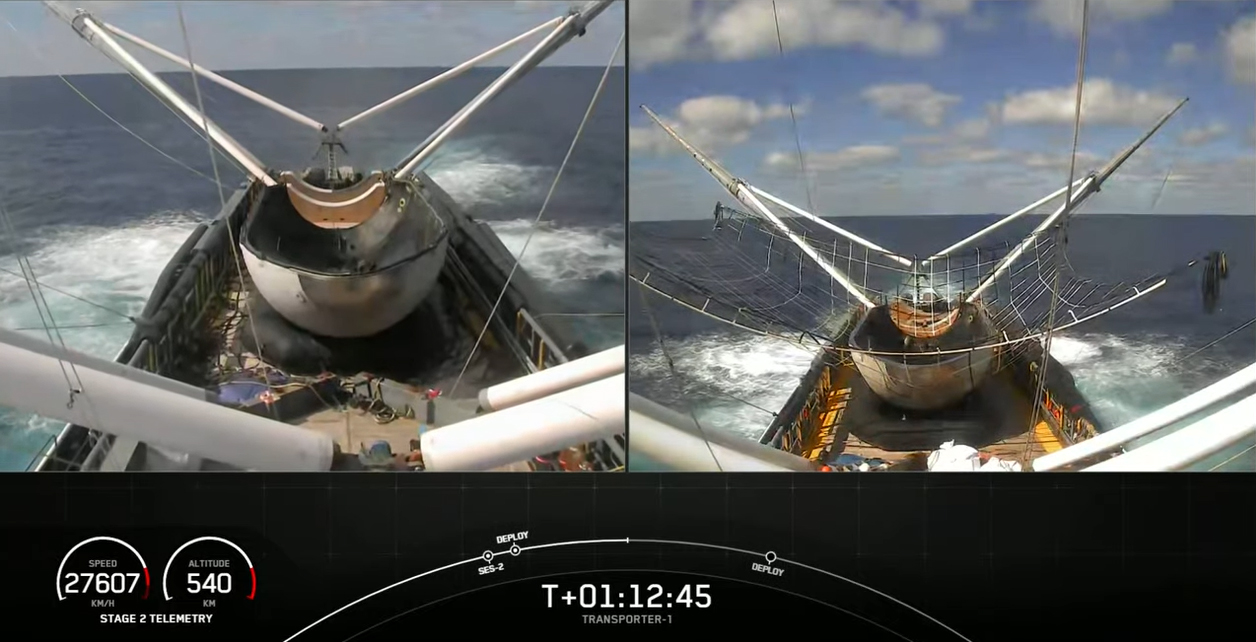SpaceX launches a record 143 satellites on one rocket, aces landing
CAPE CANAVERAL, Fla. — SpaceX successfully launched an ambitious rideshare mission as one of its veteran boosters hoisted 143 small satellites — a new record for a single rocket — into space before nailing a landing at sea.
The two-stage Falcon 9 rocket lifted off Sunday morning (Jan. 24), soaring into a blue sky dotted with clouds at 10 a.m. EST (1500 GMT) from the Space Launch Complex 40 at Cape Canaveral Space Force Station here in Florida.
Perched atop the veteran launcher is a stack of 143 satellites as part of SpaceX's first dedicated rideshare mission, called Transporter-1. The flight allowed SpaceX to flex its ridesharing muscles in a carefully choreographed orbital ballet as its flagship rocket ferried its largest number of payloads yet.
Acting as a cosmic carpool, SpaceX sent the bevy of small satellites into space alongside 10 of its own Starlink internet satellites. The mission is expected to deposit the flat-paneled Starlink satellites in a unique polar orbit — a first for its broadband fleet that will help provide coverage to customers in Alaska and other polar regions.
As such, the rocket appeared to launch straight overhead and into the clouds as it leapt off the pad this morning.
Video: Watch SpaceX record-setting launch 143 satellites!



Sunday's launch marks the third mission this year for SpaceX and the company's second within a week from Florida's Space Coast. On Wednesday (Jan. 20), SpaceX launched a full stack of its Starlink satellites atop a different Falcon 9 as part of a record-breaking mission. (The booster used on that mission became the first in SpaceX's fleet to launch and land eight times.)
Breaking space news, the latest updates on rocket launches, skywatching events and more!
The rocket powering today's mission is also a frequent flier, marking its fifth flight on the Transporter-1 mission. Known as B1058, the booster first entered service in May 2020 when it launched two NASA astronauts—Bob Behnken and Doug Hurley— into space as part of NASA's first crewed mission under the agency's Commercial Crew program. Called Demo-2, the flight marked the first astronaut mission to the International Space Station to launch from U.S. soil since the retirement of the space shuttle program in 2011.
The booster, which is adorned with NASA's iconic worm logo, also ferried a communications satellite for South Korea’s military, a batch of Starlink satellites and a Dragon cargo capsule to the space stationfor SpaceX's 21st resupply mission in December.
Originally slated to blast off on Saturday morning, the complex Transporter-1 mission was delayed 24 hours due to poor weather conditions at the launch site. On Sunday, those rainy conditions were replaced by clouds and sunshine, allowing the Falcon 9 rocket and its record-setting payload to get off the groundright on time.
Following a successful liftoff, the Falcon 9's first stage landed on SpaceX's drone ship "Of Course I Still Love You" in the Atlantic Ocean. The catch marked the 73rd recovery of a first-stage booster for SpaceX and the first catch of the year for the company's main drone ship, after receiving some needed refurbishments. (SpaceX's two other launches this year landed their first-stage boosters on a separate drone ship, "Just Read The Instructions.")
SpaceX's very big year: A 2020 of astronaut launches, Starship tests & more
A massive fleet of tiny satellites
For its fifth act, which came just over a month after its last flight, the veteran Falcon 9 acted as a space taxi service to deliver the 143 Transporter-1 mission satellites into orbit. The mission was the first in a dedicated series of rideshares as part of a program SpaceX created to help smaller satellites get into space by sharing a ride and reducing costs.
The company announced in 2019 that it would offer rides on its Falcon 9 rockets at certain intervals throughout the year and for $1 million per launch. Those flights can be booked through a dedicated website that SpaceX created.
Rideshares missions are not exactly new for SpaceX. The company has sent payloads to space for multiple companies, including a similar rideshare mission in 2018. That flight, dubbed SSO-A, delivered 64 satellites into low-Earth orbit, launching from SpaceX’s California launch pad in December 2018.
Since then, SpaceX has shared space with other payloads to space on a few of its Starlink missions. Those missions included small cubesat satellites for Planet and BlackSky. It also launched the Beresheet lunar lander into space for Israel in 2018.
Related: See the evolution of SpaceX's rockets in pictures
Onboard this flight will be 133 commercial satellites (meaning paying customers for SpaceX) and 10 of the company's own Starlink internet satellites. The complex rideshare was in part facilitated by Spaceflight Inc., which helps small satellites book their perfect ride to space. The company Exolaunch also arranged to fly 30 satellites for customers. Three small CubeSats are flying for NASA's V-Rx3 mission to test new technologies for spacecraft communication and navigation.
Until recently, smaller satellites have had limited options, squeezing in on missions wherever there’s room. But as launch costs decrease and with the advent of smaller launchers, like Rocket Lab's Electron and Virgin Orbit's services, smaller satellites have more options than ever on hitching a ride to space.
However, launching that many satellites at once is no easy task. Each one has to deploy in a timed sequence so as to avoid potential collisions. To address that challenge, specialized launch dispensers are used as well as free-flying transfer stages that will then deploy payloads once they are in a certain orbit.
The deployment sequence is carefully timed, with 48 tiny satellites for the Earth-observing company Planet beginning to deploy at just under 59 minutes after liftoff. The last satellites to leave the rocket’s upper stage will be SpaceX’s 10 Starlink satellites that are intended to provide better coverage to those in the polar regions.
Also on board will be three Hawk 2 satellites that will be part of a global constellation of radio satellites that will be used to help monitor and locate emergency beacons and improve response times in emergencies.
There are also two Taiwanese satellites, YUSAT and IDEASat, which will improve maritime navigation and help map out the Earth's ionosphere, respectively. IDEASat will make measurements of the ionosphere’s structure, identifying plasma disturbances that could interfere with satellite and radio communications.
PlanetIQ is sending a GNSS Navigation and Occultation Measurement Satellite (GNOMES) that will beam back data to help with weather forecasting, climate research as well as to help monitor space weather.
There are dozens of other payloads on board, including a payload called Celestis 17 that contains cremated human remains, and a payload called the Extremely Low Resource Optical Identifier (ELROI) that will test the use LED lights (which basically serve as a license plate for a satellite) to help identify objects in orbit.
Polar flight
The launch trajectory for this mission is also a bit unique. It will follow a similar path as one that launched last summer from Cape Canaveralthe Cape. After liftoff, the rocket hugged the east coast of Florida, heading south over the Atlantic ocean so it could deposit its payload into what's known as a polar orbit. This type of orbit allows satellites to fly over the planet's poles.
This type of orbit allows satellites to fly over the planet'’s poles. Typically these types of flights launch from the West Coast as they can more easily avoid populated areas. However, last summer, SpaceX received permission to launch flights bound for polar orbits for the first time since the 1960s.
That's because SpaceX's workhorse, the Falcon 9, is equipped with an automated flight termination system which will destroy the rocket in case something goes amiss during flight. (Historically, there would be a human in charge of the system, which isn’t as precise as a computer.) And in the late 1960s, debris from a Thor rocket reportedly killed a cow in Cuba, ending the cycle of polar launches from Florida.
One of SpaceX's two fairing recovery boats — called GO Ms. Chief — will retrieve the rocket’s two fairing halves after they splashdown in the ocean. The boat will scoop the pieces out of the water and haul them back to Port, along with the fairings from the Starlink mission that launched on Jan. 20. (Those fairings are currently already on board the other fairing ship, GO Ms. Tree.)
Up next for SpaceX is another Starlink mission, which could blast off as early as next week. The company also has two additional Transporter missions on the schedule for 2021 — one as early as June and another expected in December.
Follow Amy Thompson on Twitter @astrogingersnap. Follow us on Twitter @Spacedotcom or Facebook.

Amy Thompson is a Florida-based space and science journalist, who joined Space.com as a contributing writer in 2015. She's passionate about all things space and is a huge science and science-fiction geek. Star Wars is her favorite fandom, with that sassy little droid, R2D2 being her favorite. She studied science at the University of Florida, earning a degree in microbiology. Her work has also been published in Newsweek, VICE, Smithsonian, and many more. Now she chases rockets, writing about launches, commercial space, space station science, and everything in between.


